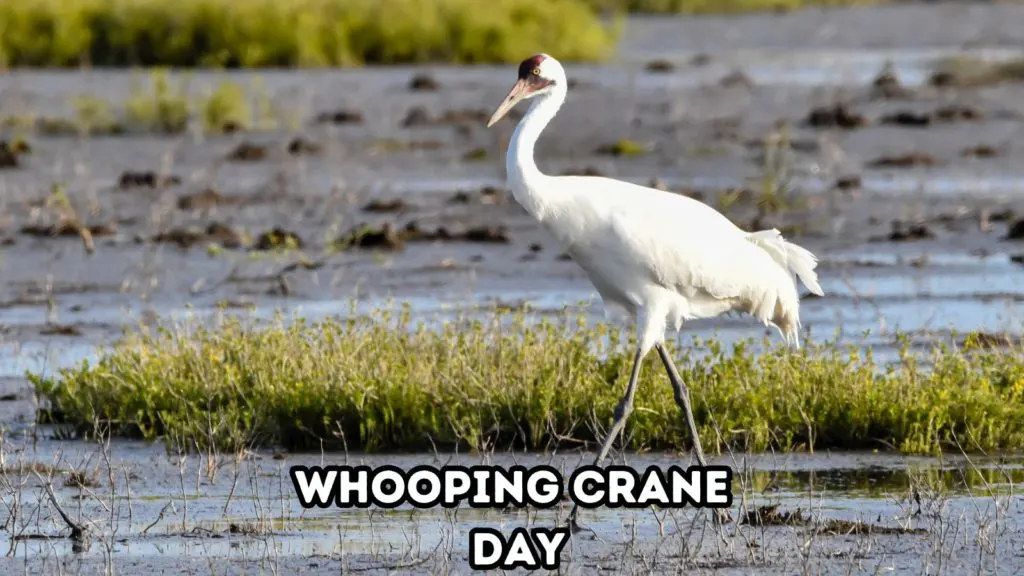Every year, nature enthusiasts, bird lovers and conservationists celebrate Whooping Crane Day. These majestic birds, known for their striking white plumage and impressive stature, are a symbol of successful conservation efforts and the beauty of avian wildlife.
The Whooping Crane, North America’s tallest bird, faced near extinction in the 20th century. With relentless conservation efforts, their numbers have seen a significant rise, reminding us of the impact we can have when we work together for a common cause.

When is Whooping Crane Day?
Whooping Crane Day is celebrated every year on May 28.
Where Can You See Whooping Cranes?
The best places to see Whooping Cranes are typically those where they migrate or have been reintroduced. Here are some of the top locations:
Aransas National Wildlife Refuge, Texas: This refuge on the Gulf Coast of Texas is one of the most famous wintering grounds for Whooping Cranes. Visitors can see the cranes feeding and interacting in their natural habitat from late October through April.

We’ve been lucky enough to visit this refuge several times and spotted the whooping cranes. You can visit by car or take a guided tour from nearby Rockport, Texas (the best way to get closer to the birds). The cranes are also celebrated every February at the Whooping Crane Festival in nearby Port Aransas.
Wood Buffalo National Park, Canada – Platte River, Nebraska: Wood Buffalo National Park in Canada is the primary breeding ground for Whooping Cranes. However, during migration, these birds can be observed along the Platte River in Nebraska, offering a spectacular sight in spring.
Necedah National Wildlife Refuge, Wisconsin: This refuge is home to a reintroduced population of Whooping Cranes, part of a project to create a self-sustaining population in the eastern United States. The best time to visit is during the spring and fall migrations.
Kissimmee Prairie Preserve State Park, Florida: Part of the reintroduction efforts, this park in central Florida is home to a non-migratory population of Whooping Cranes. Visitors can see them year-round, although spotting them may require some patience and luck.
Cheyenne Bottoms Wildlife Area and Quivira National Wildlife Refuge, Kansas: These locations are important stopovers during the Whooping Cranes’ migration. The best time to visit is during the spring and fall migrations.
When planning a trip to these locations, it’s important to remember that Whooping Cranes are still a rare and endangered species. Observing them should be done at a respectful distance to avoid disturbing them. Additionally, the timing of migrations can vary each year, so it’s a good idea to check with the local wildlife refuges or parks for the best viewing opportunities.
Fun Facts About Whooping Cranes
Here are 20 fun facts about them:
- Tallest North American Bird: Whooping Cranes are the tallest birds in North America, standing up to 5 feet tall.
- Impressive Wingspan: They have an impressive wingspan, ranging from about 7 to 8 feet.
- Distinctive Call: Their name comes from their distinctive “whooping” call, which can be heard over long distances.
- Endangered Species: They are an endangered species, with a dramatic recovery from just about 21 birds in the 1940s to over 800 today.
- Long Lifespan: In the wild, Whooping Cranes can live up to 24 years, and even longer in captivity.
- Migration Experts: They migrate up to 2,500 miles from their breeding grounds in Canada to their wintering grounds in Texas.
- Unique Mating Dance: Whooping Cranes are known for their elaborate and graceful mating dances, which include bowing, jumping, and wing-flapping.
- Monogamous Birds: They are monogamous and often mate for life, with both parents raising the young.
- Color of the Chicks: The chicks are cinnamon brown when born, turning white as they mature.
- Rarely Twins: It’s rare for Whooping Cranes to have twins; usually, only one chick survives per season.
- Diverse Diet: Their diet is diverse, including insects, fish, crabs, and grain.
- Indicator Species: They are considered an indicator species, meaning their health reflects the health of their environment.
- Flock Size: While migrating, Whooping Cranes fly in small groups but may join other flocks, forming larger groups.
- Protective Parents: The parents are very protective of their young, often attacking anything that comes close to their nest.
- Cultural Symbol: The Whooping Crane is a symbol of wildlife conservation in North America.
- Distinctive Features: Adults have red and black facial markings and a distinctive black “mustache.”
- Water Dependence: They depend on wetlands for survival, making wetland conservation crucial for their preservation.
- Flight Speed: In flight, Whooping Cranes can reach speeds up to 35 miles per hour.
- Reintroduction Programs: Several successful reintroduction programs have helped increase their populations in areas where they had disappeared.
- Fossil Records: Fossil records indicate that Whooping Cranes have been in North America for millions of years.
More Bird Holidays
BirdTipper features dozens of bird holidays; here some other observances you might enjoy:
- 8 Letter Bird Names - August 14, 2024
- 7 Letter Bird Names - August 14, 2024
- 7 Birds Named After Famous People - July 23, 2024
